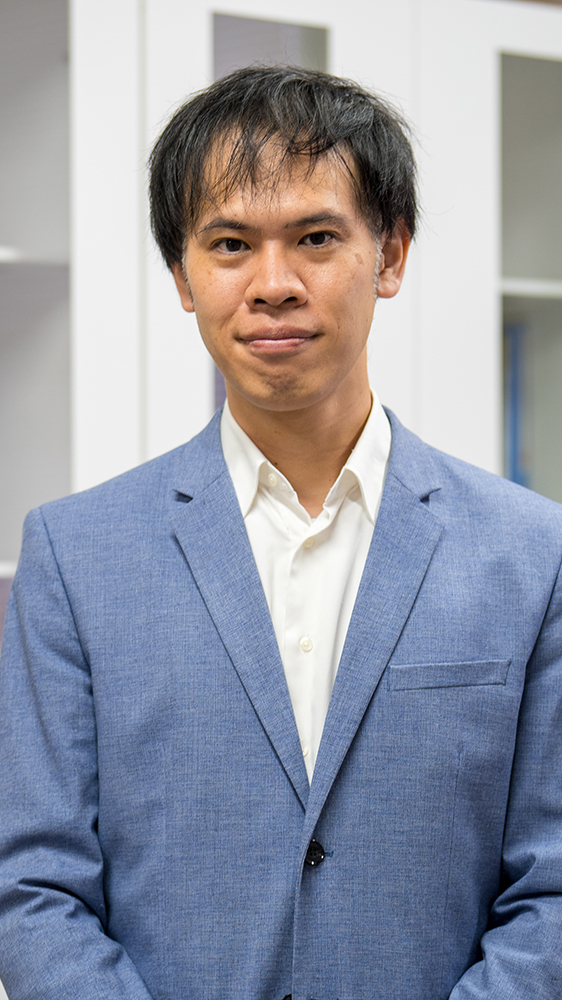ENERGY CONVERSION QUANTUM CHEMISTRY
KEN-ICHI UCHIDA YUSUKE NAKANISHI LAB.
INTRODUCTION OF LABORATORY
To improve the performance of today’s electron devices dramatically, it is essential to incorporate new device materials with higher functionality. In the electron device operations, the carrier density change in semiconductors occurs in the near-interface region within several or tens of nanometers of the interface between the semiconductor and the insulating layer. Therefore, in order to fully utilize new device materials, it is essential to control the atomic arrangement and physical properties in this nano-region near the interface, by designing appropriate fabrication processes based on the deep understanding of the properties of those materials. For example, it is contributing to an energy-saving society to signicantly improve the efciency of power devices for electric power conversion, by fully utilizing wide-gap semiconductors instead of Si as the new device material. The materials showing superior dielectric properties such as ferroelectricity in nanometer-thick lms, are expected to be applied to new non-volatile memory technology that will support the next-generation computing.

バルク材料合成技術や薄膜作製技術を駆使して自然界には存在しない複合材料を生み出し、高効率に熱変換・熱制御・熱移送するための基盤原理・技術を構築しています。

本研究室が開発した「熱電永久磁石」の写真。この材料は永久磁石でありながら、電流を流すと電流と直交した方向に熱流が流れて片面を冷却したり、温度差を与えることで発電したりすることができます。

MESSAGE
DISCOVER AND OBSERVE PHENOMENA BY OURSELF AND LAY THE FOUNDATION FOR NEW RESEARCH FIELDS. LET’S CREATE WORLD-LEADING RESEARCH FROM JAPAN.
Ever since I was a child, my parents never told me to do anything and I decided on my carrier by myself including the selection of the university. In fact, I never once thought of becoming a researcher until I started my research. I chose to be a researcher because I found that I like doing research.
The field of spin caloritronics has developed from a physical phenomenon I discovered when I was an undergraduate student in Keio University. This is a field that offers great opportunities for students to play an active role. Currently, we are working not only on basic research, but also on how to evelop the various principles discovered in spin caloritronics for practical applications. Our laboratory conducts research in cooperation with Spin Caloritronics Group, Research Center for Magnetic and Spintronic Materials, National Institute for Materials Science (NIMS) in Tsukuba. Students in this laboratory can use state-of-the-art facilities not only at Univ. Tokyo but also at NIMS.
keyword
Spin current / spintronics / spin Seebeck effect / spin caloritronics / thermal control / magneto-thermoelectric effect / magnetic materials / lock-in thermography / anomalous etchingshausen effect / spin Peltier effect / anomalous Nernst effect / magnetism / spin electronics / magnetic materials / reverse Spin Hall effect / Phonon / Amorphous / Magnetic thin film / Lock-in thermography / Thermoelectric conversion / Ferron / Ferroelectric / Transport properties / Thermoelectric effect / Thomson effect / Thermal engineering / Dielectric properties / Magnon / Thin film / Sonic properties / Physical properties experiment / Sound waves / Spin Hall effect
PROFILE : Professor Ken-ichi Uchida
2008 B. Eng., Keio University, Japan
2009 M. Sc. Eng., Keio University, Japan
2012 Ph.D. (Physics), Tohoku University, Japan
2012 Assistant Professor, Institute for Materials Research, Tohoku University
2014 Associate Professor, Institute for Materials Research, Tohoku University
2016 Group Leader, Research Center for Magnetic and Spintronic Materials, National Institute for Materials Science
2023 Distinguished Group Leader, Research Center for Magnetic and Spintronic Materials, National Institute for Materials Science
2024 Professor, Graduate School of Frontier Sciences, The University of Tokyo
Associate Professor Yusuke Nakanishi
2012.4-2013.3 Mitsubishi Chemical Corporation
2016.4-2017.3 Overseas Postdoctoral Fellow, JSPS (Department of Materials Science & NanoEngineering)
2017.4-2018.9 YLC Designated Assistant Professor, Institute for Advanced Research
2018.10-2024.7 Assistant Professor, Department of Physics, Graduate School of Science, Tokyo Metropolitan University
2024.8-present Associate Professor, Department of Advanced Materials Science, Graduate School of Frontier Science, The University of Tokyo
Keyword
NanoScience / Materials Science / Physical Chemistry

NEW MATERIALS AND INTERFACES
Freely manipulate thermal energy by making full use of new principles, materials, and devices.






Ken-ichi Uchida Yusuke Nakanishi Lab.,
Department Of Advanced Materials Science,
Graduate School of Frontier Sciences,
The University of Tokyo
Kashiwanoha 5-1-5,
Kashiwa,Chiba 277-8561, Japan
+81-4-7136-3756(Kashiwa)
+81-29-859-2062(NIMS)
kuchida@edu.k.u-tokyo.ac.jp
The Goal of Applied Physics
The goal of Applied Physics is to develop a stage = “new material” that can manipulate undeveloped degrees of freedom, to explore unknown phenomena created from that stage and to bring out excellent functions, and to bring out its excellent functions. The purpose is to contribute to the development of human society by elucidating the mechanisms and developing application fields for these phenomena and functions.
AMS (Advanced Materials Science)
Department Office
AMS (Advanced Materials Science),
Graduate School of Frontier Sciences,
The University of Tokyo
Kashiwanoha 5-1-5, Kashiwa, Chiba 277-8561, Japan
Email : ams-office(at)ams.k.u-tokyo.ac.jp
Please change (at) to @.
